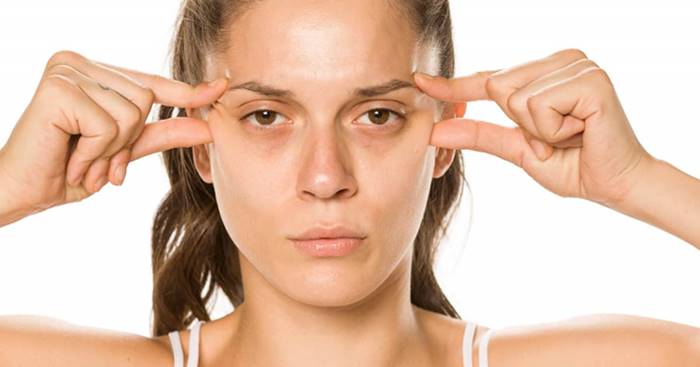Dark circles, also known as periorbital hyperpigmentation, under the eyes are a common cosmetic concern that can make people appear unhealthy, aged, or tired. Various factors contribute to their development, such as skincare habits, lifestyle, and genetics.
Among the misconceptions surrounding the causes of dark circles, one often-debated issue is whether crying can lead to their formation. In this article, we will delve into the relationship between crying and dark circles to address whether tears are truly responsible for this cosmetic woe.
Dark circles are the result of skin structure and blood vessels around the eyes. The skin in this region is thinner than the rest of the face and is more prone to revealing the pigmentation changes and the underlying blood vessels. Factors such as aging, genetics, sun exposure, and lack of sleep can all contribute to the appearance of dark circles.
Does Crying Cause Dark Circles?

Yes, crying can contribute to the appearance of dark circles. Emotional tears can cause fluid retention and swelling around the eyes, creating shadows that make the under-eye area look darker. However, lack of sleep, genetic factors, and other lifestyle elements also play a key role in the development of chronic dark circles.
Tears and Their Composition
Tears are composed of enzymes, mucus, oils, and water that help protect and nourish the eyes. When excess tears are produced due to irritation, emotions, or other factors, they can accumulate around the eyes and potentially cause puffiness. This swelling can cast shadows on the thin and delicate under-eye skin, making it appear darker than usual. However, this effect is typically temporary and subsides once the fluid balance returns to normal.
Other Contributing Factors
As mentioned earlier, UV exposure, genetics, and inadequate sleep play significant roles in the formation of dark circles. Genetics can influence the prominence of blood vessels and the thickness of the skin, making some people more prone to dark circles regardless of their crying habits.
Lack of sleep can lead to paler skin, which can accentuate darknessand the appearance of blood vessels. UV (ultraviolet) exposure can lead to skin pigmentation changes, making the area under the eyes appear darker.
Prevention and Management
To manage or prevent dark circles, consider the following steps:
- Skincare Routine: Using moisturizers and products containing ingredients like vitamin C and hyaluronic acid can help improve skin tone and texture.
- Adequate Sleep: Getting enough quality sleep can help minimize the appearance of dark circles and maintain skin health.
- Healthy Lifestyle: Staying hydrated, maintaining a balanced diet, and managing stress can contribute to overall skin health.
- Sun Protection: Wearing sunglasses and sunscreen to shield the delicate skin around the eyes from UV (ultraviolet) rays can prevent pigmentation changes.
- Cosmetic Treatments: For persistent dark circles, cosmetic treatments like laser therapy, topical creams, and chemical peels can be considered under the guidance of a dermatologist.
FAQs
Why do dark circles appear after crying?
After crying, blood vessels around the eye area can dilate due to pressure and increased blood flow. This can caues the appearance of dark circles as the skin in that area is thin and the underlying blood vessels surrounding your eyes become more visible. Additionally, crying can cause fluid retention and inflammation, further contributing to the appearance of dark circles.
What are effective remedies for reducing dark circles caused by crying?
Effective remedies for reducing dark circles caused by crying include using caffeine-infused creams, applying cold compresses, getting enough sleep,using cucumber slices, staying hydrated, and using skin-lightening ingredients like retinoids and vitamin C.
Can hydration help in preventing or reducing dark circles after crying?
Yes, staying well-hydrated can help reduce and prevent dark circles after crying by reducing the visibility of blood vessels and improving skin elasticity.
What role does sleep play in managing dark circles after crying?
Adequate sleep helps manage dark circles after crying by preventing fluid retention, reducing inflammation, and promoting skin regeneration, which can improve their appearance.
Are there specific skincare products for addressing dark circles from crying?
Yes, skincare products like eye creams containing ingredients such as retinoids, hyaluronic acid, caffeine, and vitamin C can help address dark circles caused by crying.
How do stress and emotional distress relate to dark circles after crying?
Emotional distress and stress can lead to disrupted sleep patterns and poor sleep quality. When a person is emotionally distressed or stressed, their body releases stress hormones that can effect their ability to fall asleep and stay asleep. This lack of quality sleep can contribute to the development of dark circles after crying. In addition to this, emotional distress and stress can cause blood vessels to dilate, leading to potential swelling and increased blood flow to the under-eye area, which can further exacerbate the appearance of dark circles.
Are there makeup techniques to hide under-eye circles resulting from crying?
Yes, there are some makeup techniques to hide under-eye circles resulting from crying. Using a color corrector, followed by a concealer that matches your skin tone, can efficiently cover dark circles. Applying in a triangular shape, with the base along your lower lash line and the point towards your cheek, can provide effective natural-looking coverage. Setting with translucent powder helps prevent creasing and ensures long-lasting coverage.
How can one differentiate between regular dark circles and those caused by crying?
Regular dark circles are often related to aging, genetics, or lifestyle factors, while those caused by crying are generally more temporary and can involve additional inflammation and puffiness due to the physiological response of tears.
Are there any long-term effects of repeated crying on under-eye circles?
Repeated crying can contribute to long-term under-eye circles by promoting inflammation, weakening blood vessels, causing skin thinning, and potentially making them more persistent over time.
Is it possible to prevent puffy eyes and dark circles when dealing with excessive crying?
While it’s difficult to completely prevent dark circles during and puffy eyes excessive crying, you can reduce their appearance by applying soothing creams, using cold compresses, practicing relaxation techniques, and staying hydrated to reduce fluid retention and inflammation.
What are some relaxation techniques that might reduce both crying and dark circles?
Relaxation techniques such as engaging in calming activities, progressive muscle relaxation, meditation, and deep breathing can help reduce both crying and the appearance of dark circles by minimizing the physiological responses and managing stress that contribute to their occurrence.
Conclusion
Crying is not the primary cause of dark circles. It can lead to temporary puffiness around the eyes. UV exposure, genetic predisposition, lack of sleep, and other lifestyle factors play more significant roles in their development. Understanding the complex interplay of these factors can help people make informed decisions about preventing and managing dark circles for a healthier and more vibrant appearance


